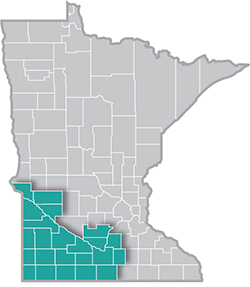 Southwest Minnesota is a national leader in agricultural production, and renewable energy.
Southwest Minnesota is a national leader in agricultural production, and renewable energy.
The region's thriving manufacturing sector includes food processing, machinery, printing, metal products, and computers and electronic products.
Want the freshest data delivered by email? Subscribe to our regional newsletters.
7/7/2022 9:00:00 AM
Luke Greiner
Even accounting for the record levels of current demand, Minnesota's Southwest Region is also projected to see job growth of nearly 7,700 new jobs over the next decade. DEED's Employment Projections through 2030 start with the recession-depressed job counts from 2020, and therefore some of the expected growth is actually remaining job recovery. However, even once the region gets back to pre-pandemic employment levels, there is expected to be some additional growth.
This includes faster gains in the industries that were hardest hit, including Arts, Entertainment & Recreation, Accommodation & Food Services and Other Services, which typically are not among the fastest growing industries in our 10-year forecasts. To that end, Health Care & Social Assistance is again expected to be the largest growing and one of the fastest growing industries, potentially accounting for just over one-third of total projected job gains through 2030.
Other industries that should see steady growth in the region include Educational Services, Manufacturing, Construction, Transportation & Warehousing, and Public Administration. In contrast, only four of the 20 main industries are projected to lose jobs over the decade, with the biggest decline predicted in Retail Trade as consumer behaviors continue to change, and on-going declines for self-employed and agriculture workers. Though relatively small, Information is expected to see the fastest decline, cutting 7% of employment from 2020 to 2030 (see Table 3).
| Table 3. Southwest Minnesota Industry Employment Projections, 2020-2030 | ||||
|---|---|---|---|---|
| Industry | Estimated Employment 2020 | Projected Employment 2030 | Percent Change 2020-2030 | Numeric Change 2020-2030 |
| Total, All Industries | 195,812 | 203,504 | +3.9% | +7,692 |
| Health Care & Social Assistance | 29,352 | 32,081 | +9.3% | +2,729 |
| Manufacturing | 30,107 | 30,719 | +2.0% | +612 |
| Self-Employed & Unpaid Family Workers | 21,926 | 21,257 | -3.1% | -669 |
| Retail Trade | 18,569 | 17,653 | -4.9% | -916 |
| Educational Services | 15,564 | 16,274 | +4.6% | +710 |
| Public Administration | 13,193 | 13,517 | +2.5% | +324 |
| Accommodation & Food Services | 10,089 | 12,268 | +21.6% | +2,179 |
| Wholesale Trade | 8,045 | 8,118 | +0.9% | +73 |
| Construction | 7,573 | 8,082 | +6.7% | +509 |
| Transportation & Warehousing | 7,385 | 7,817 | +5.8% | +432 |
| Other Services | 6,756 | 7,462 | +10.4% | +706 |
| Finance & Insurance | 6,780 | 6,921 | +2.1% | +141 |
| Agriculture, Forestry, Fishing & Hunting | 5,674 | 5,753 | +1.4% | +79 |
| Professional & Technical Services | 3,788 | 4,006 | +5.8% | +218 |
| Admin. Support & Waste Mgmt. Services | 3,421 | 3,636 | +6.3% | +215 |
| Arts, Entertainment, & Recreation | 1,655 | 2,114 | +27.7% | +459 |
| Information | 2,152 | 2,001 | -7.0% | -151 |
| Management of Companies | 1,495 | 1,506 | +0.7% | +11 |
| Real Estate & Rental & Leasing | 1,318 | 1,311 | -0.5% | -7 |
| Utilities | 713 | 735 | +3.1% | +22 |
| Mining | 257 | 273 | +6.2% | +16 |
| Source: DEED 2020-2030 Employment Outlook | ||||
In summary, labor force constraints are clearly becoming the biggest limiting factor to economic growth in Southwest Minnesota. Without more workers in the labor force, it's possible that peak employment for the foreseeable future remains in the past. However, the region has welcomed increasing age and racial diversity over the past two decades and will need to continue to bring more and new workers into the labor force to meet these challenges.
Contact Labor Market Analysts Luke Greiner at 320-308-5378.